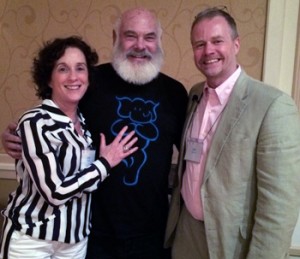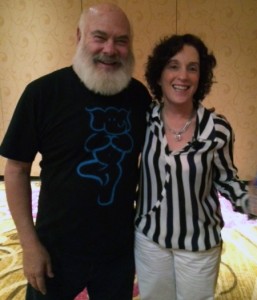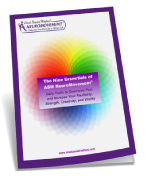Anat Baniel Presents at Arizona Center for Integrative Medicine
Preconference Event – The Language of Pain
 On May 4, 2014, we presented at the Preconference Event for the 11th Annual Nutrition and Health Conference in Dallas, Texas. This conference is “the premier nutrition conference for health professionals in the U.S.” It is sponsored by the Arizona Center for Integrative Medicine at the University of Arizona College of Medicine.
On May 4, 2014, we presented at the Preconference Event for the 11th Annual Nutrition and Health Conference in Dallas, Texas. This conference is “the premier nutrition conference for health professionals in the U.S.” It is sponsored by the Arizona Center for Integrative Medicine at the University of Arizona College of Medicine.
Dr. Neil Sharp and I were thrilled to speak with Faculty and Alumni of the Fellowship of the Arizona Center for Integrative Medicine.
The subject of the preconference event was “The Language of Pain.”
Our two-hour, experiential presentation was titled NeuroMovement®: Leveraging the Power of Brain Change to Overcome Pain.
Chronic Pain Means the Loss of Connections
Current research shows that when pain becomes chronic, there are measurable changes in the brain both in the motor and sensory areas. Specifically, there is loss of inhibitory connections that are necessary for skillful refined movement and action.
In one study, when subjects were introduced to stimulation that required them to notice differences, the pain was significantly reduced. Whereas, with the control group, when they simply got stimulation, there was no change.
Find more details about the current research and studies on pain below.
The Nine Essentials Help the Brain’s Process of Differentiation
Each and every one of the 9 Essentials of the Anat Baniel Method are mechanisms to wake up the brain and drive it to resume the process of differentiation and then integration, intentionally and in a highly potent way.
If you’d like to read more about differentiation and the brain, you can find this topic discussed in the last chapter of my book Move Into Life, and in chapter 3 of Kids Beyond Limits, titled “Your Child’s Amazing Brain.”
Dr. Andrew Weil, Founder of AZ Center for Integrative Medicine

It was so wonderful to connect with Dr. Andrew Weil and his team, and the doctors attending the conference.
They are an incredible group of people who are committed to changing and improving medicine and bring more healing to all of us.
I invite those of you who attended to share your experience with us on social media. We’d love to hear from you.
Anat Baniel
Learn more about the Arizona Center for Integrative Medicine.
View our video on Pain Relief and Anat Baniel Method NeuroMovement.
Read the story of Maria: A Journey from Pain and Chronic Fatigue to Health and Healing.
Supporting Pain Research and Studies
Find a number of pain studies here—click here.
Moseley, G. L., & Flor, H. (2012). Targeting cortical representations in the treatment of chronic pain a review. Neurorehabilitation and neural repair, 26(6), 646-652. http://www.bodyinmind.org/wp-content/uploads/Moseley-Flor-2012-Neurorehab-Neural-Rep-targeting-the-brain-in-rehab-review.pdf
Yang TT, Gallen C, Schwartz B, Bloom FE, Ramachandran VS, Cobb S. Sensory maps in the human brain. Nature. 1994;368:592-593
Flor H, Elbert T, Knecht S, et al. Phantom-limb pain as a perceptual correlate of cortical reorganization following arm amputation. Nature. 1995;375:482-484.
Juottonen K, Gockel M, Silen T, Hurri H, Hari R, Forss N. Altered central sensorimotor processing in patients with complex regional pain syndrome. Pain. 2002;98:315-323.
Tecchio F, Padua L, Aprile I, Rossini P. Carpal tunnel syndrome modifies sensory hand cortical somatotopy: a MEG study. Hum Brain Mapp. 2002;17:28-36.
Flor H, Braun C, Elbert T, Birbaumer N. Extensive reorganization of primary somatosensory cortex in chronic back pain patients. Neurosci Lett. 1997;224:5-8.
Find more pain studies and research—click here.
Lotze M, Grodd W, Birbaumer N, Erb M, Huse E, Flor H. Does use of a myoelectric prosthesis prevent cortical reorganization and phantom limb pain? Nat Neurosci. 1999;2:501-502.
Moseley GL, Zalucki NM, Wiech K. Tactile discrimination, but not tactile stimulation alone, reduces chronic limb pain. Pain. 2008;137:600-608
Moseley GL. I can’t find it! Distorted body image and tactile dysfunction in patients with chronic back pain. Pain. 2008;140:239-243.



